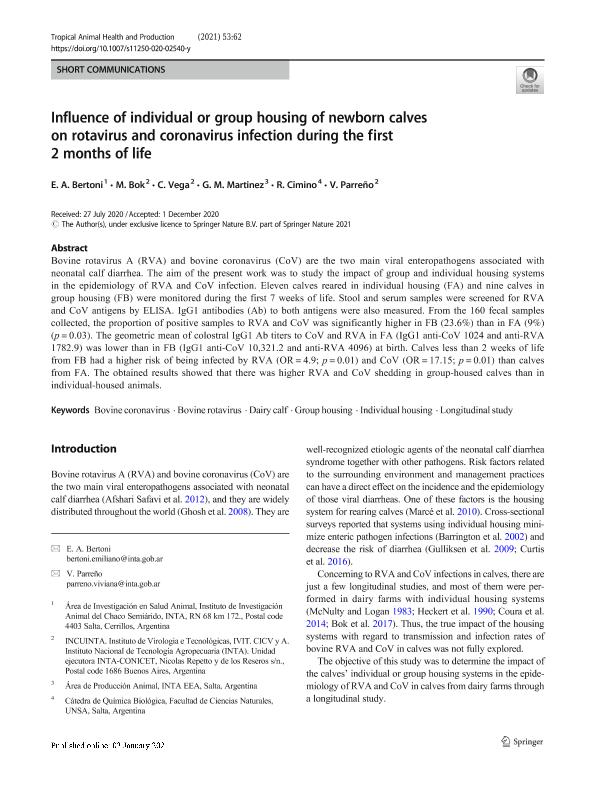Artículo
Influence of individual or group housing of newborn calves on rotavirus and coronavirus infection during the first 2 months of life
Bertoni, Emiliano; Bok, Marina ; Vega, Celina Guadalupe
; Vega, Celina Guadalupe ; Martinez, G. M.; Cimino, Rubén Oscar
; Martinez, G. M.; Cimino, Rubén Oscar ; Parreño, Gladys Viviana
; Parreño, Gladys Viviana
 ; Vega, Celina Guadalupe
; Vega, Celina Guadalupe ; Martinez, G. M.; Cimino, Rubén Oscar
; Martinez, G. M.; Cimino, Rubén Oscar ; Parreño, Gladys Viviana
; Parreño, Gladys Viviana
Fecha de publicación:
03/01/2021
Editorial:
Springer
Revista:
Tropical Animal Health And Production
ISSN:
0049-4747
Idioma:
Inglés
Tipo de recurso:
Artículo publicado
Clasificación temática:
Resumen
Bovine rotavirus A (RVA) and bovine coronavirus (CoV) are the two main viral enteropathogens associated with neonatal calf diarrhea. The aim of the present work was to study the impact of group and individual housing systems in the epidemiology of RVA and CoV infection. Eleven calves reared in individual housing (FA) and nine calves in group housing (FB) were monitored during the first 7 weeks of life. Stool and serum samples were screened for RVA and CoV antigens by ELISA. IgG1 antibodies (Ab) to both antigens were also measured. From the 160 fecal samples collected, the proportion of positive samples to RVA and CoV was significantly higher in FB (23.6%) than in FA (9%) (p = 0.03). The geometric mean of colostral IgG1 Ab titers to CoV and RVA in FA (IgG1 anti-CoV 1024 and anti-RVA 1782.9) was lower than in FB (IgG1 anti-CoV 10,321.2 and anti-RVA 4096) at birth. Calves less than 2 weeks of life from FB had a higher risk of being infected by RVA (OR = 4.9; p = 0.01) and CoV (OR = 17.15; p = 0.01) than calves from FA. The obtained results showed that there was higher RVA and CoV shedding in group-housed calves than in individual-housed animals.
Archivos asociados
Licencia
Identificadores
Colecciones
Articulos (IVIT)
Articulos de INSTITUTO DE VIROLOGIA E INNOVACIONES TECNOLOGICAS
Articulos de INSTITUTO DE VIROLOGIA E INNOVACIONES TECNOLOGICAS
Articulos(CCT - SALTA-JUJUY)
Articulos de CTRO.CIENTIFICO TECNOL.CONICET - SALTA-JUJUY
Articulos de CTRO.CIENTIFICO TECNOL.CONICET - SALTA-JUJUY
Citación
Bertoni, Emiliano; Bok, Marina; Vega, Celina Guadalupe; Martinez, G. M.; Cimino, Rubén Oscar; et al.; Influence of individual or group housing of newborn calves on rotavirus and coronavirus infection during the first 2 months of life; Springer; Tropical Animal Health And Production; 53; 52; 3-1-2021; 1-6
Compartir
Altmétricas



